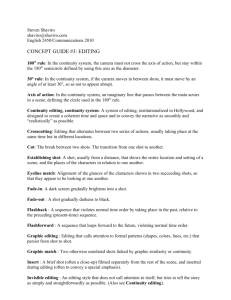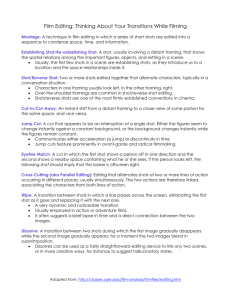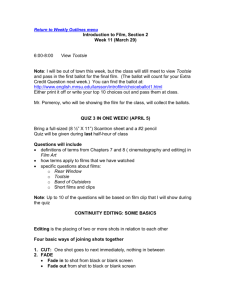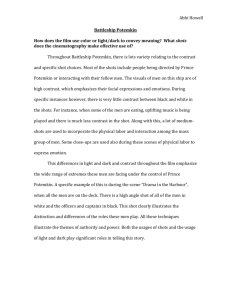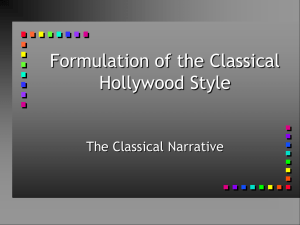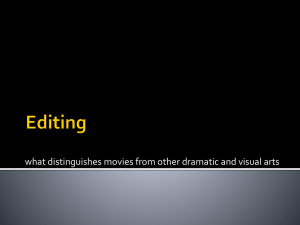Larsson's notes, week 12
advertisement
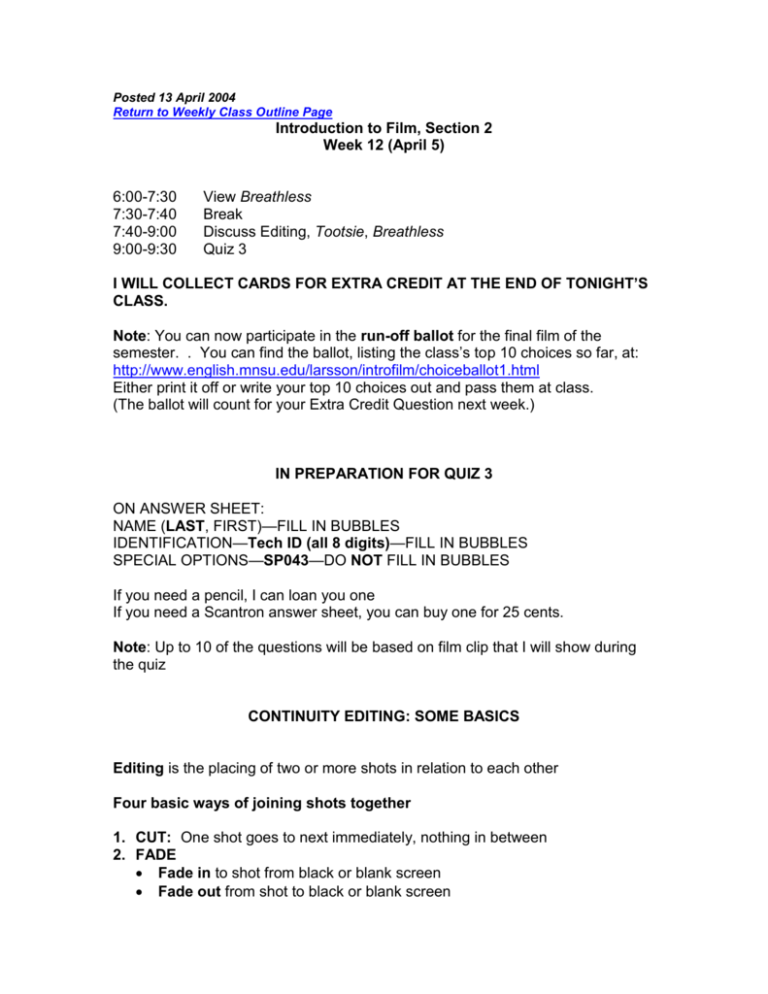
Posted 13 April 2004 Return to Weekly Class Outline Page Introduction to Film, Section 2 Week 12 (April 5) 6:00-7:30 7:30-7:40 7:40-9:00 9:00-9:30 View Breathless Break Discuss Editing, Tootsie, Breathless Quiz 3 I WILL COLLECT CARDS FOR EXTRA CREDIT AT THE END OF TONIGHT’S CLASS. Note: You can now participate in the run-off ballot for the final film of the semester. . You can find the ballot, listing the class’s top 10 choices so far, at: http://www.english.mnsu.edu/larsson/introfilm/choiceballot1.html Either print it off or write your top 10 choices out and pass them at class. (The ballot will count for your Extra Credit Question next week.) IN PREPARATION FOR QUIZ 3 ON ANSWER SHEET: NAME (LAST, FIRST)—FILL IN BUBBLES IDENTIFICATION—Tech ID (all 8 digits)—FILL IN BUBBLES SPECIAL OPTIONS—SP043—DO NOT FILL IN BUBBLES If you need a pencil, I can loan you one If you need a Scantron answer sheet, you can buy one for 25 cents. Note: Up to 10 of the questions will be based on film clip that I will show during the quiz CONTINUITY EDITING: SOME BASICS Editing is the placing of two or more shots in relation to each other Four basic ways of joining shots together 1. CUT: One shot goes to next immediately, nothing in between 2. FADE Fade in to shot from black or blank screen Fade out from shot to black or blank screen 3. DISSOLVE: Ending of one shot overlaps beginning of next shot 4. WIPE: Line moves across screen, “wiping” away one shot and revealing new one underneath. Cut is most common type. WIPE is least common (almost disappeared after 1950s but has made a comeback in film and television). All types except cut are somewhat gradual, often imply transitions or changes of time or space some other variations: swish-pan, iris out or iris in EDITING AND SHOT CONTENT: 4 AREAS TO CONSIDER GRAPHIC Relations: How does each shot look compared to the one before or after? Similar (graphic match): enhances continuity or calls attention to itself Different (graphic discontinuity): may not call attention to itself or may undermine sense of continuity RHYTHMIC Relations: How long is the duration of each shot compared to the one before or after? Steady number of frames from shot to shot: steady pace or rhythm Shots become longer: sense of slowing down Shots become shorter: sense of speeding up SPATIAL Relations: Where are the people and objects of the first shot in relation to the same space in the next shot? May emphasize continuity or discontinuity in space. TEMPORAL Relations: When do the events in the first shot happen in relation to the events in the next shot? May emphasize continuity or discontinuity in time. Graphic and Rhythmic Relations apply to all films that use editing. Spatial and Temporal Relations apply mainly to narrative films (including nonfiction). CONTINUITY EDITING Also referred to as “Hollywood editing” or “invisible editing” Develops in early years of filmmaking (1900-1910) Highly developed as set of “rules” to be followed by early 1920s Still in effect today in film and TV despite some adaptation System has absorbed some practices once thought to be “violations” of “rules” of editing Purpose is to assure that the audience has a sense of continuity in Space Time Narrative Some major devices used in continuity editing (Each can work against continuity if the “rules” are not followed): General Pattern: 1. Establishing shot 2. Breakdown of scene into closer shots 3. Re-establishing shot (if needed) Purpose: Establishes overall space where a scene will occur. Allows closer shots with little confusion about where people and objects are. 180-Degree Rule: Keeps all action in all shots on one side of straight line (180 degree arc) in a scene (the “axis of action”) C C C C C ----------------------------------------------------------------------- X C=Possible camera position X=”Wrong” camera position Purpose: Assures continuity of direction of motion Assures continuity of position of characters, objects Assures overlapping background space from shot to shot Allows shot/reverse shot setups in conversations, etc. Eyeline Match Shot of person looking offscreen, followed by shot of what he or she “sees” Purpose: Establishes connection in space between person looking and what is seen. Eyeline matches establish what Jeff “sees” in Rear Window. Match on Action Action in one shot is continued in next shot, even though camera has changed position. Purpose: Allows camera to change position without calling attention to the change. Crosscutting Cuts between shots of actions occurring in two or more different places (usually at the same time) Purpose: Creates links in time, cause-and-effect, theme among actions Montage Sequence Relatively long process or period of story duration is conveyed in short amount of screen duration by series of short shots. Purpose: Allows narrative to summarize series of actions or events. NARRATIVE AND EDITING IN TOOTSIE Follows conventions of Classical Hollywood Narrative Actions are motivated by goals and desires of Michael Dorsey as character. Traits established early on: Talented actor, trusted teacher Loyal to friends Unemployed Impatient, hard to work with Tries to take advantage of women in personal relationships Complications: No one will hire him because of his temperament Needs money to produce Jeff’s play Sandy fails to get part for soap opera Goals Established: Get money Produce play Prove that he can work well with others Opportunity: Uses opening at soap opera to create “Dorothy Michaels” Complications: Having to cope with false identity o Leads to “love” affair with Sandy Adjusting to expectations about women: looks, personality, target for sexual harassment Falling in love with Julie Becoming object of jealousy for Sandy, of affection for Les and Van Horn Becoming popular and role model for women fans Having contract extended New Opportunity Leads to Resolution: Show has to broadcast live, cannot be edited Michael creates revelation about Dorothy’s character Closure: High Degree of Resolution with Some Opennness Sandy becomes a stronger woman, stars in Jeff’s play Play is produced Michael and Les reconcile Michael and Julie reconcile, appear to be ready to start romance EDITING Follows conventions of continuity editing with some modern variations Establishing shot-breakdown-reestablishing shot pattern 180-degree rule usually followed Eyeline matches, matches on action, crosscutting used to enhance continuity in time, space, cause-and-effect Cuts to new scenes are not always set up by transitional devices like fades or wipes Montage Sequences are used to establish situations, give plot information efficiently Opening: Close-ups of makeup create curiosity ambiguity when applied to male face, but justified by moustache being glued on Short scenes of Michael trying out for plays are cross-cut with shots of him teaching acting Sequence concludes with Michael stressing importance of finding and keeping a part Party Scene: Establishes Michael’s popularity but also his hitting on women Establishes Jeff’s pretensions as “artistic” (not “popular”) playwright and humor Establishes Sandy’s passivity Going to Work/Rising Popularity: Daily routine of getting into disguise/costume Shots of “Dorothy” signing autographs Shots of secretaries, others watching show “Dorothy” photographed for magazines covers with celebrities (Gene Shalit, Andy Warhol), ends with multiple-frame (split-screen) shot Country Weekend Shots of “Dorothy,” Julie and Les establish growing attraction toward to Julie (and of Les toward Dorothy) Baby-Sitting Difficulty of coping with baby while Julie is breaking up with Ron Conclusions and Meaning Uses conventions of classical Hollywood narrative and editing to deal with potentially controversial material. Referential Meaning: Assumes some familiarity with soap operas and conventions (especially in “revelation” speech at end) Explicit Meaning: “I was a better man with women when I was a woman than I ever was when I was just a man” Relationships require understanding and respect by men towards women Implicit Meaning: Heterosexual relationships are the norm (Virtually no actually gay characters at all in film) Women still need men to show them how to assert themselves (Julie, Sandy become stronger women and better actresses because of Michael) Symptomatic Meaning: Explicit Meaning reflects advances of Women’s Movement in decade before Tootsie was made But Implicit Meaning reflects social uneasiness at “breakdown” of traditional gender roles Heterosexuality has to be reasserted as norm to keep from going so far as to alienate mainstream audiences BREATHLESS AND EDITING One of first films of French Nouvelle Vague (“New Wave”) Godard begins as movie critic for Cahiers du cinema (with Francois Truffaut, Claude Chabrol, Eric Rohmer, Jacques Rivette, etc.) champion American auteurs in studio system: Hitchcock, John Ford, etc. denounce “well-made” films that lack intensity, personality or emotion look at low-budget American films and pulp crime fiction for models recognize and name American “film noir” as trend in Hollywood film from 1940s-1950s Breathless: dedicated to Monogram Pictures (“Poverty Row” Hollywood studio specializing in low-budget films) criminals-on-run theme similar to Truffaut’s Shoot the Piano Player Narrative does not conform to Classical Hollywood Narrative Exact goals of characters are not totally clear Reasons for actions are not always stated Complications and conflict take time to get established Long scenes delay forward motion of narrative Ending and Patricia’s final gesture are ambiguous Camerawork calls attention to itself Editing continually violates “rules” of continuity editing Crosses “the line” against the 180-degree rule Creates false eyeline matches Use of jump cuts—cuts without significant shift in camera position and no apparent break in time Conclusions: Like many of Godard’s films, referential meaning is introduced for its own sake but some suggest how modern life is defined by images and movies (Humphrey Bogart as role model for Michel) Explicit meaning is lacking Implications are left for audience to determine Begins Godard’s long love-hate relationship with movies. Always in love with the movie past, always critical of the social present. Later moves into more radical, “Marxist” phase of difficult movies that openly critique capitalist society and images as commodities More recently, moves away from overtly political themes to deal with human relationships and film, but always disappointed in both Compare opening of remake, with Richard Gere, directed by Jim McBride (1983) Return to top

